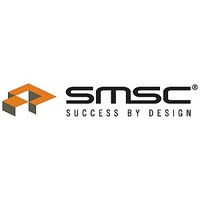LPC47M107S-MS Standard Microsystems (SMSC), LPC47M107S-MS Datasheet - Page 92

LPC47M107S-MS
Manufacturer Part Number
LPC47M107S-MS
Description
Manufacturer
Standard Microsystems (SMSC)
Datasheet
1.LPC47M107S-MS.pdf
(188 pages)
Specifications of LPC47M107S-MS
Pin Count
100
Lead Free Status / RoHS Status
Compliant
Available stocks
Company
Part Number
Manufacturer
Quantity
Price
Company:
Part Number:
LPC47M107S-MS
Manufacturer:
SMSC
Quantity:
3 000
Company:
Part Number:
LPC47M107S-MS
Manufacturer:
Standard
Quantity:
1 036
Company:
Part Number:
LPC47M107S-MS
Manufacturer:
Microchip Technology
Quantity:
10 000
Part Number:
LPC47M107S-MS
Manufacturer:
SMSC
Quantity:
20 000
SER_IRQ Cycle Control
There are two modes of operation for the SER_IRQ Start Frame.
1) Quiet (Active) Mode: Any device may initiate a Start Frame by driving the SER_IRQ low for one clock, while the
SER_IRQ is Idle. After driving low for one clock the SER_IRQ must immediately be tri-stated without at any time
driving high. A Start Frame may not be initiated while the SER_IRQ is Active. The SER_IRQ is Idle between Stop
and Start Frames. The SER_IRQ is Active between Start and Stop Frames. This mode of operation allows the
SER_IRQ to be Idle when there are no IRQ/Data transitions which should be most of the time.
Once a Start Frame has been initiated the Host Controller will take over driving the SER_IRQ low in the next clock
and will continue driving the SER_IRQ low for a programmable period of three to seven clocks. This makes a total
low pulse width of four to eight clocks. Finally, the Host Controller will drive the SER_IRQ back high for one clock,
then tri-state.
Any SER_IRQ Device (i.e., The LPC47M10x) which detects any transition on an IRQ/Data line for which it is
responsible must initiate a Start Frame in order to update the Host Controller unless the SER_IRQ is already in an
SER_IRQ Cycle and the IRQ/Data transition can be delivered in that SER_IRQ Cycle.
2) Continuous (Idle) Mode: Only the Host controller can initiate a Start Frame to update IRQ/Data line information.
All other SER_IRQ agents become passive and may not initiate a Start Frame. SER_IRQ will be driven low for four to
eight clocks by Host Controller. This mode has two functions. It can be used to stop or idle the SER_IRQ or the Host
Controller can operate SER_IRQ in a continuous mode by initiating a Start Frame at the end of every Stop Frame.
An SER_IRQ mode transition can only occur during the Stop Frame. Upon reset, SER_IRQ bus is defaulted to
Continuous mode, therefore only the Host controller can initiate the first Start Frame.
Slaves must
continuously sample the Stop Frames pulse width to determine the next SER_IRQ Cycle’s mode.
SER_IRQ Data Frame
Once a Start Frame has been initiated, the LPC47M10x will watch for the rising edge of the Start Pulse and start
counting IRQ/Data Frames from there. Each IRQ/Data Frame is three clocks: Sample phase, Recovery phase, and
Turn-around phase. During the Sample phase the LPC47M10x must drive the SER_IRQ low, if and only if, its last
detected IRQ/Data value was low. If its detected IRQ/Data value is high, SER_IRQ must be left tri-stated. During the
Recovery phase the LPC47M10x must drive the SER_IRQ high, if and only if, it had driven the SER_IRQ low during
the previous Sample Phase. During the Turn-around Phase the LPC47M10x must tri-state the SER_IRQ. The
LPC47M10x will drive the SER_IRQ line low at the appropriate sample point if its associated IRQ/Data line is low,
regardless of which device initiated the Start Frame.
The Sample Phase for each IRQ/Data follows the low to high transition of the Start Frame pulse by a number of
clocks equal to the IRQ/Data Frame times three, minus one. (e.g. The IRQ5 Sample clock is the sixth IRQ/Data
Frame, (6 x 3) - 1 = 17th clock after the rising edge of the Start Pulse).
Page 92















